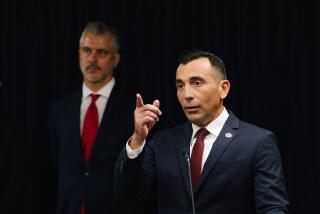Pentagon Plans $877-Million Anti-Drug Effort : Military: The expanded initiatives include special training and surveillance. It is a reversal of Defense Department reluctance to join the war on narcotics.
WASHINGTON — The Pentagon, unveiling an $877-million package of military drug-fighting initiatives, said Friday it plans to erect an “aerostat fence” along the southern border and increase the total steaming, training and flying hours dedicated to halting the flow of drugs.
Pentagon officials said that, as of Jan. 1, more ships, aircraft and military personnel got their marching orders to join the war on drugs, reversing years of military reluctance to participate in what the Pentagon’s drug chief once called “the President’s crusade.”
Defense Secretary Dick Cheney, in a statement released by the Pentagon, said: “We will act swiftly, methodically and in accordance with our nation’s laws and traditions” to take part in the coordinated anti-drug campaign initiated by President Bush.
Defense officials were quick to note that, even though the Pentagon clearly is expanding its participation in the drug war, the military’s role in the campaign will be subject to strict limits.
For instance, National Guardsmen and active-duty soldiers, accompanied by military drug-sniffing dogs, will help U.S. Customs Service agents inspect cargo for drugs under the Pentagon proposal. But the military personnel will focus on surveillance, passing information to U.S. and foreign law enforcement authorities who would perform actual arrests.
Although the new strategy does not assign any new anti-drug missions to the Defense Department, Pentagon officials said it represents a significant commitment of additional resources to the effort.
“It is more of the same, but it is substantially more of the same,” said Stephen M. Duncan, the Pentagon’s drug czar.
Duncan warned, however, that U.S. efforts would take a long time to bear fruit and said the effectiveness of the military’s participation could not be measured by increased arrests or drug seizures.
While some in Congress have long urged an increased military role in the anti-drug war, critics have complained that military operations are costly and less effective than civilian education, treatment and interdiction efforts.
The Pentagon’s plans also increased concerns among some lawmakers and public interest groups that the military’s expanded role could further erode the legal doctrine that bars servicemen and servicewomen from participating in law enforcement functions.
“I greatly fear for our civil liberties as the traditional separation between the civilian and the military is further breached,” said Rep. Don Edwards (D-San Jose), who characterized the military expansion as “enormous” and “very shocking.”
The armed services plan to step up their provision of intelligence, communications and logistics support, as well as interdiction training, to local drug-fighting efforts in the cocaine-producing countries of Colombia, Peru and Bolivia.
Defense officials said, for instance, that special U.S. military teams will help train and equip Colombian, Peruvian and Bolivian forces to conduct operations along South America’s vast river networks.
In the Caribbean Sea, four to five ships will ply the heavily trafficked area daily in search of drug runners, an operational increase of about 80%. Flight hours by U.S. surveillance aircraft will rise by 220% this year over 1989’s level, Duncan said.
In the Pacific, U.S. naval forces that previously played a minor role in gathering drug-related intelligence will see a “dramatic increase” in their efforts, the Pentagon said.
Navy ships operating out of Pacific Command ports will devote the equivalent of 867 days of patrol to waters close to Asian nations and nearer to the United States in search of drug traffickers. That would represent a 146% increase in the Pacific drug-fighting efforts by surface ships. Navy warplanes would increase drug-related patrols by 24%.
American military forces already have broken new ground by joining in efforts to eradicate marijuana fields on federal lands in the Hawaiian Islands. Under the Pentagon plan, active-duty forces and National Guardsmen would conduct similar operations over state lands if requested.
The military’s “aerostat fence”--15 sensor-laden balloons and blimps strung across the southern U.S. border--would be completed by 1992, defense officials said. Their gaze would be supplemented by 44 ground-based radar installations along the border.
Meanwhile, about 50 American interceptor aircraft would remain on alert to “scramble” toward potential drug traffickers and monitor their approach to U.S. territory.
Col. Lawrence Izzo, a military planner for the Joint Chiefs of Staff, said that while U.S. warplanes would not be able to open fire on suspected drug traffickers, they would operate under guidelines that permit them to defend themselves if fired on.
Duncan said that Cheney has agreed to begin a cooperative study by the Defense Department and the Justice Department’s Bureau of Prisons to investigate how Defense Department facilities could be used to house overflow prisoners.
In a proposal expected to bring an expanded military presence to Long Beach, Duncan said that the Pentagon will establish four new regional logistics support offices around the nation--slated for New York, Florida, California and Texas.
While officials have not identified the sites, a Defense Department source said that Long Beach appears to be the principal location under consideration in California.
More to Read
Sign up for Essential California
The most important California stories and recommendations in your inbox every morning.
You may occasionally receive promotional content from the Los Angeles Times.











